Abstract
The diagnosis and treatment of pelvic organ prolapse (POP) remain a relevant and scientifically challenging topic. The number of cases of genital prolapse increases each year, one in ten women need at least one surgical procedure and one in four women in midlife have asymptomatic prolapse. Using mesh implants to correct POP presents unsatisfactory clinical outcomes, requiring hospital readmission and further surgery. We hypothesize using an alternative surgical intervention technique, applying injectable biodegradable cog threads, currently used for face lifting procedures, to reinforce and correct vaginal wall defects. The threads used in this investigation are commercially available 360° 4D barb threads (PCL-19G-100), made of polycaprolactone (PCL), supplied in sterile packs (Yastrid, Shanghai, China). Eleven sows’ vaginal walls were used to analyze the immediate reinforcement effect of the threads. Uniaxial tensile testing and scanning electron microscopy (SEM) was performed for the initial characterization of the threads. Threads were inserted into the vaginal wall (control n = 5, cog n = 5) and were characterized by ball burst testing; a pull-out test was performed (n = 6). With SEM images, dimensions, such as thread diameter (≈630 µm), cut angle (≈135°), cut depth (≈200 µm) and cog distance (≈1600 µm) were measured. The mechanical behavior during uniaxial tensile testing was nonlinear. Threads could sustain 17–18 N at 18–22% of deformation. During the ball burst test, vaginal tissue reinforced with threads could support 68 N more load than normal tissue (p < 0.05), indicating its strengthening effect. Comfort and stress zones were significantly stiffer in the tissues reinforced with threads (p < 0.05; p < 0.05). Both groups showed identical deformation (elongation); no significant differences in the comfort zone length were observed, showing that threads do not affect tissue compliance. The pull-out test showed that the threads could sustain 3.827 ± 0.1891 N force when the first cog slip occurs, at 11.93 ± 0.8291 mm. This preliminary research on using PCL cog threads for POP treatment showed promising results in increased vaginal wall resistance to pressure load and, at the same time, not affecting its compliance. Nevertheless, to obtain long term host response in vivo, further investigation will be carried out.
1. Introduction
When pelvic floor tissues, muscles, ligaments and fascia become weakened, overstretched or injured, pelvic organs generally supported by these structures can bulge into the vaginal wall [1]. This condition is called pelvic organ prolapse (POP) and affects millions of women worldwide [2], significantly influencing their quality of life. POP is a pelvic floor dysfunction (PFD) that could increase by more than 40% by 2050 [3]. Its symptoms manifest in approximately 50% of parous women, and 1 in 10 may need surgical treatment [4]. During physiological events such as pregnancy, childbirth, menopause and ageing, pelvic floor (PF) soft tissues and organs change [5]. Previous group research showed that the vaginal wall and PF organs adapt to the delivery; however, they do not recover to original levels [6,7,8]. Vaginal delivery causes direct trauma to the PF, and many women fail to recover completely [9]. In some European countries (Germany, France and England), the admissions for POP surgery were 102 k in 2005, with a substantial cost of more than 308 M€ [10]. POP affects more than 5 k women annually in Portugal, with a likely annual increase [11].
Due to the complex nature of POP, the treatment of this disorder is complex. Early degrees of prolapse might be treated with lifestyle advice (weight loss, avoidance of heavy lifting, and physical therapy) or with special devices such as pessaries that provide additional support to the dropping pelvic organs [12]. However, the primary treatment for POP is surgery. Surgical POP correction might be divided based on the approach and how the defect is repaired [13]. The surgery might be vaginal or abdominal (by open abdomen or by laparoscopy) and using native tissue or implants, whether these are used to reinforce or substitute the weakened endorsement. Alternatively, other procedures, such as colpocleisis (stitching of the anterior and posterior vaginal walls), are typically performed for elderly patients when it is impossible to use other methods.
Unfortunately, the native tissue repairs present unsatisfactory clinical outcomes and have a relatively high failure rate (19%), leading to PFD development in other compartments [14]. New surgery can manage it, which may then use an implant (mesh) to provide additional support for weakened or damaged tissue [15]. Most surgical meshes currently available in clinics are made from non-absorbable synthetic polymers (polypropylene); however, due to the lack of reliable preclinical data, vaginal mesh use is associated with an unacceptable risk for graft related complications (GRCs) [16]. At least 10% of GRCs following vaginal implantations occur due to inappropriate biomechanical properties of synthetic implants, next to patient and surgeon factors, including foreign body reaction, mesh contraction, mesh exposure, infection and pain [17,18]. Thereby, the Food and Drug Administration (FDA) ordered some manufacturers to immediately stop distributing surgical meshes because “reasonable confidence in the safety and effectiveness of these devices” used to treat POP has not been demonstrated since the agency categorized them as high risk [19].
Since surgeons rely on prosthetic materials to treat POP, using approaches currently applied in face lifting may be a solution for POP treatment. Face-shaping supports being lost, especially around the cheeks, the eye area, the jowls and the neck is one of the telltale features of ageing, which are due to progressive soft-tissue laxity [20,21]. Thread lifting is becoming popular among patients despite its less effective lifting result. It does not require sedation or general anesthesia, has long-lasting recovery, and has fewer related complications [20,22]. Thread lifting is a minimally invasive procedure to restore sagging facial skin by applying surgical threads [23]. This therapy has many advantages: it can be performed under local rather general anesthesia; it has a shorter operative time and quick recovery; lower complication risk; it usually does not present visible scars; and it is cheaper than conventional procedures [24]. Thus, based on the benefits of this procedure, its application is possible in different medical fields in which the standard sutures succeed, such as wound closure and face lifting. Cog threads were used in 2008 in obstetric and gynecologic practices for tissue reapproximation during a laparoscopic myomectomy and some hysterectomies [25]. Therefore, it seems possible to apply this technique for POP treatment with some effort and investigation.
This research aims to study an alternative surgical technique for POP correction by applying biodegradable cog threads, currently used for face lifting procedures, to reinforce and correct vaginal wall defects. Threads inserted into the vaginal wall under specific angles will create a mesh-like structure, matching physiological compliance and providing additional support. Being embedded into the vaginal wall, the threads provoke the body’s healing reaction, causing large direct surges of collagen to treated areas, thereby improving and stimulating collagen generation around the filaments and their barbs [24]. This technique’s advantage is the possibility of starting treatment for women with early prolapse stages, with a possibility of having a vaginal delivery in the future—something not possible with conventional meshes [26]. Since the thread’s barbs firmly anchor into the soft tissue, no additional anchoring points are needed, reducing the material burden, which can cause an inflammatory reaction [27]. Moreover, the procedure could be personalized by the injected threads number, material choice and thread type [21].
2. Materials and Methods
2.1. Cog Threads
Threads used in this research are commercially available 360° 4D barb threads (PCL-19G-100), made of polycaprolactone (PCL), supplied in sterile packs (Yastrid, Shanghai, China). The pack contained two pieces of the threads in the cannula (L type) and a needle (19 G). Cannula and needles were made of stainless steel. Once implanted, their expected duration is between 2 and 3 years.
Threads were carefully removed from the cannula for characterization. The initial characterization of these threads was accomplished with scanning electron microscopy (SEM) assistance. The specimens were sputter-coated with a thin Au/Pd film by the SPI Module Sputter Coater. SEM was carried out by a high resolution (Schottky) environmental SEM with X-ray microanalysis and electron backscattered diffraction analysis (FEI Quanta 400 FEG ESEM/EDAX Genesis X4M).
The uniaxial tensile tests were conducted on the Multitest 2.5 dV machine with a 100 N load cell by applying longitudinal axial load on the threads (Figure 1A). The specimens were held by the clamps, pre-loaded to 0.1 N, and stretched until the failure at 10 mm/min speed [28].
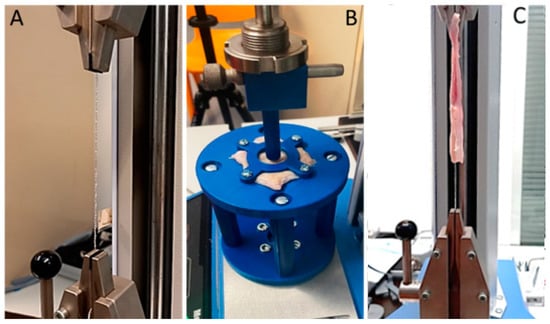
Figure 1.
(A) Cog thread uniaxial tensile testing; (B) Vaginal wall-cog thread ball burst testing; (C) Vaginal wall strips—cog thread pulling test.
2.2. Animal Tissue
Eleven sows’ pelvic floor soft tissues were collected at the slaughterhouse (Matadouro Carneiro e Salgueirinho Lda, NCV D 13, Trofa, Portugal) for research purposes. The procedures respected the conditions imposed by Regulation (EC) No. 1069/2009 of 21 October. The animal parts were acquired as a block, vaginal canal together with rectum, muscles and surrounding fat (Figure 2A). Therefore, the vaginal canal was first separated (Figure 2B).
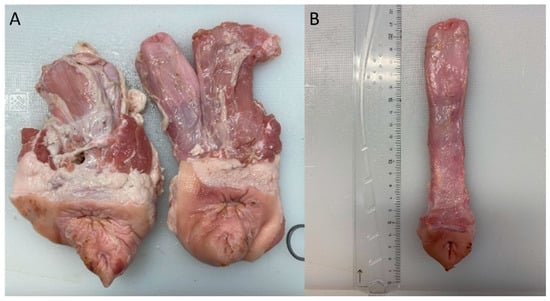
Figure 2.
(A)—pelvic floor soft tissues collected from the slaughterhouse; (B)—separated vaginal canal.
Vaginal canals were opened longitudinally along the urethra, and the distal part of the vagina was selected for thread insertion (control n = 5, cog n = 5) and characterized by ball burst testing. One vaginal wall was divided into strips (n = 6) for the uniaxial thread pull-out test.
2.3. Ball Burst Test
The thread insertion procedure was performed under the guidance of neuropathologist Dr J. Vasciliene, who specializes in face rejuvenation procedures and thread use. The needle was used for initial surface perforation (Figure 3A). Square specimens (50 × 50 mm) were prepared for the thread insertion. A cannula with a cog was inserted until the end of the sample, then turned and carefully removed, while the cog thread stayed fixed in the tissue (Figure 3B). Two cog threads were inserted into the tissue under the 90° angle, intersecting and creating the non-rigid reinforcement.
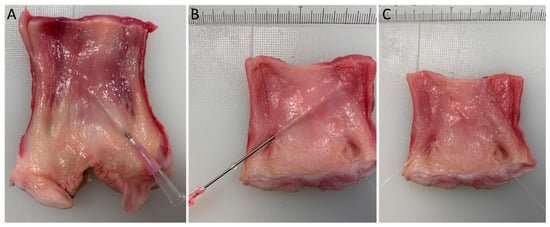
Figure 3.
(A) Vaginal wall specimen with a needle (procedure beginning); (B) Vaginal wall specimen with an inserted cannula and cog thread (intersecting under 90° angle). (C) Vaginal wall specimen with 2 crossed cog threads.
Specimen mechanical characterization was performed by ball burst testing on a Mecmesin Multitest 2.5 dV tensiometer (2500 N cell load) and VectorPro software (Mecmesin Ltd., West Sussex, United Kingdom) with an 11.5 mm plunger. Before the testing, specimen thickness was measured. Then, it was clamped with the epithelium facing down and preloaded to 0.1 N. The plunger speed was estimated to be 10 mm/min until the specimen rupture (Figure 1B). The force (N) and displacement (mm) curves were used to define the stiffness.
2.4. Pull-Out Test
Vaginal wall strips (10 × 50 mm, n = 6) were used to test the thread cogs anchoring forces. Cog threads were inserted into the tissue specimens longitudinally; the vaginal tissue part was attached to the superior grip while the thread was clamped to the inferior one (Figure 1C). The tests were carried out on the Multitest 2.5 dV machine, with a load cell of 100 N applying longitudinal axial load at 10 mm/min speed.
2.5. Statistical Analysis
Statistical analyses were performed using GraphPad Prism 5 software (GraphPad Software, Inc., La Jolla, CA, USA). The Kolmogorov–Smirnov test confirmed the normality of the data. The quantitative values are expressed as the mean value ± standard error of the mean. An unpaired Student’s t-test was used to evaluate the effect of the tissue reinforcement (95% confidence level, significance level p < 0.05).
3. Results
Cog Threads
From SEM images (Figure 4), it was possible to obtain thread dimensions, such as diameter (≈630 µm), cog cut angle (≈135°), cut depth (≈200 µm) and distance between cogs (≈1600 µm); an average of three measures done in different images.

Figure 4.
PCL cog thread SEM images: (A) Thread diameter dimension (mag.—100×, scale—1 mm); (B) Cog cutting dimension (mag.—100×, scale—1 mm); (C) Cog image (mag.—350×, scale—300 µm).
Force-strain curves (Figure 5) represent the nonlinear mechanical behavior of PCL cog threads during uniaxial tensile testing. Threads could sustain 17–18 N at 18%–22% of deformation.
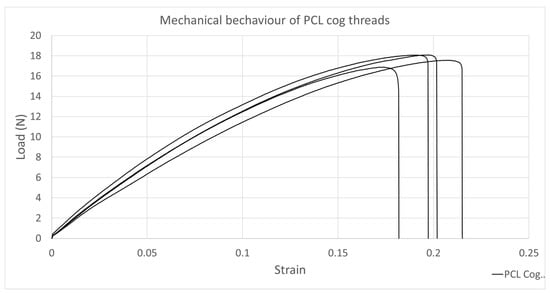
Figure 5.
Mechanical behavior of PCL cog threads under uniaxial tensile loading (n = 4).
Figure 6 displays force-strain curves for sow vagina wall mechanical behavior and when it is reinforced with PCL cog threads. The physiological deformation range considered the comfort zone was established at the range of 4%–14% of elongation [7]. The supra-physiological deformation range, stress zone, was defined throughout 65%–75% of elongation [7]. The comfort and stress zone stiffnesses were respectively estimated. Ultimate force (point A) and the maximum change in length at ultimate force (point B) were measured. An inflexion point (point C), indicates the comfort zone’s length.
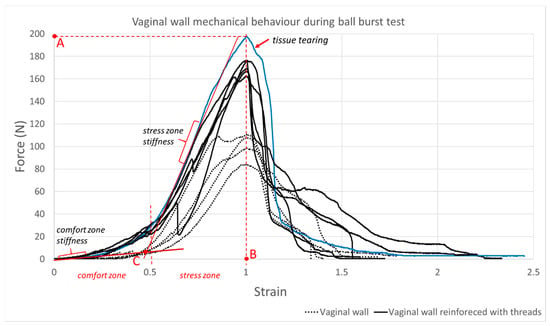
Figure 6.
Mechanical behavior of the sow vaginal wall during ball burst test with and without cog threads. A blue colored curve was used as an example to clarify studied tissues characteristics: comfort and stress zone stiffness; A—ultimate load, B—the maximum change in length at ultimate force; C—comfort zone length.
Thread reinforced vaginal tissue could sustain 68 N more load than normal tissue (p < 0.05), showing its strengthening effect (Figure 6 and Table 1). A comfort and stress zone stiffness was significantly higher in the tissues reinforced with cog threads (p < 0.05; p < 0.05). The deformation was similar in both groups, and no significant differences in the comfort zone length were observed, indicating that threads do not affect tissue compliance.

Table 1.
Mechanical characteristics of sow vaginal wall during ball burst testing. Data are presented as mean ± standard error of the mean; significant group differences were determined to p < 0.05 and noted (*).
The pull-out test was performed to analyze the resistance that the cogs of the threads may offer to the deformation of the tissue (Figure 7). The thread pull-out test showed that the thread could sustain 3.827 ± 0.1891 N force when the first cog slipping occurs at the elongation of 11.93 ± 0.8291 mm. Although a maximum resistance was obtained in a specific part of each curve (first failure), the cogs continued offering a minor resistance to the deformation during the rest of the test.
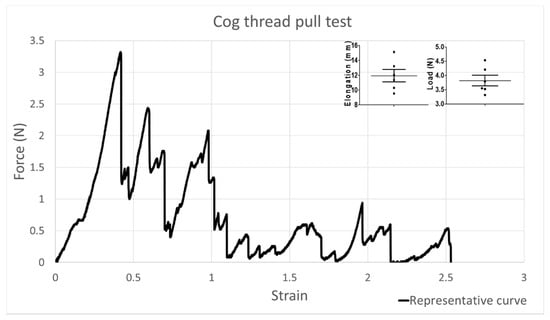
Figure 7.
Representative force-strain curve of PCL cog thread pulling from the vaginal tissue. The top right bars represent force and elongation at this force at the first cog fixation failure during the pull-out test.
4. Discussion
POP treatment remains a relevant and scientifically challenging topic. A possible solution for anterior and posterior compartment prolapse correction was presented in this study. As an alternative technique to surgical intervention, injectable biodegradable cog threads were used for vaginal wall reinforcement. The threads’ application was analyzed on the ex vivo vaginal wall to simulate the immediate reinforcement effect of the posterior vaginal wall.
The use of cog threads might have several advantages compared with mesh implants in reconstructive pelvic surgeries. Although it is mostly used in facelifting procedures, we believe it can be applied in treating the early stages of POP due to several factors. This technique reduces operative times and more straightforward wound closure since there is no need to tie knots, and it can be performed under local anesthesia [29]. Since the thread’s barbs firmly anchor into the soft tissue, no additional anchoring points are needed, reducing the material burden, which can cause an inflammatory reaction. In addition, it offers a quick recovery and better sexual health compared to conventional meshes and provides the possibility of having a vaginal delivery in the future [30]. Conventional meshes are usually used in older women with no sexual life since it is not recommended to give birth after this procedure with synthetic meshes. Due to this factor, native repairs are usually used for younger women, but they have a higher recurrence rate [30].
Cog threads are already used during obstetrical and gynecological procedures such as myomectomy, hysterectomy and sacrocolpopexy [29], mainly in superficial tissue repair since, for deep wound closure, they are not as effective [31]. Ex vivo experiments showed that thread reinforced vaginal tissue could sustain 68 N more load than normal tissue, while the deformation was similar in both groups, and no significant differences in the comfort zone length were observed. Thus, indicating a tissue strengthening effect does not affect its compliance. The thread pull-out test showed that the maximum cog thread resistance (first failure) was 3.827 ± 0.1891 N at the elongation of 11.93 ± 0.8291 mm, offering a minor resistance to the deformation during the rest of the test. Cog threads are more likely to maintain the tissue in position for better healing than standard sutures since they may result in tissue tearing at the attachment points. In contrast, cog threads provide a more uniform spread of holding forces within the tissue due to their multiple attachment points [31]. Cogs might provide sufficient fixation strength without interfering with tissue compliance [31]. Moreover, using these threads allows for personalizing the treatment, and easily changing the density of the supporting structure according to the patient’s needs by changing the number of cogs used to create reinforcement (in facial thread lifting, generally, from 2 to 30 threads can be inserted per procedure) [29].
Based on the literature, inserted threads provoke the body’s healing reaction, improve collagen formation, and increase elastin volume around the threads and cogs [32]. After complete absorption (two to three years to dissolve fully, results may vary among patients), the material is replaced by collagen-rich connective tissue [33]. These reactions may have an additional positive impact on vaginal wall properties. Collagen fibers play a dominant role in the elastin and collagen contributions to the tissue’s load-bearing. Collagen is primarily responsible for soft tissue tensile strength, whereas elastin makes the tissue more flexible [7]. The rate of graft-related problems is also expected to decrease as less foreign material implies a less inflammatory reaction [34].
Despite all the advantages that cog threads can provide, it is essential to understand that this type of suture does not have a long-lasting effect when used in face lifting [34]. Furthermore, the tests performed with these threads for face-lifting procedures reported some complications, namely swelling, bruising (most frequent complications), skin dimpling, contour irregularities, intractable pain, paresthesia, infection, and mild asymmetry. Nevertheless, the overall reported rate of severe complications with the thread-lift suture is low, and the use of bioresorbable implantation materials/biodegradable polymers seems to make this procedure even safer since they are less harmful to viscera and reduce infections [25,33,34].
5. Conclusions
Research results showed that cog threads could provide immediate additional strength to the vaginal wall and, at the same time, match its physiological compliance. Nevertheless, further research will follow to investigate the short and long-term response of the vaginal wall reinforcement in vivo in sheep models.
Author Contributions
Conceptualization, R.R. and P.M.; methodology, R.R., P.M. and C.S.; software, C.S. and R.R.; validation, E.S. and L.H.; formal analysis, C.S., P.M., E.S., L.H. and R.R.; investigation, C.S., E.S. and L.H.; resources, R.R.; data curation, C.S. and R.R.; writing—original draft preparation, C.S. and R.R.; writing—review and editing, P.M., E.S., L.H.; visualization, R.R. and C.S.; supervision, R.R.; project administration, R.R.; funding acquisition, R.R. All authors have read and agreed to the published version of the manuscript.
Funding
This research was funded by the Ministry of Science, Technology, and Higher Education, FCT, Portugal and the Operational Program of Competitiveness and Internationalization—POCI under project PRECOGFIL—PTDC/EMD-EMD/2229/2020.
Institutional Review Board Statement
Ethical review and approval were waived for this study since INEGI and DGAV (Direção-Geral da Alimentação e Veterinária, Portugal), celebrated protocol with registry number N19128UDER. Such protocol authorizes INEGI to collect animal tissue in slaughterhouses for research/educational purposes. Moreover, all procedures respected the conditions imposed by Regulation (EC) No. 1069/2009 of 21 October, on health rules concerning animal by-products and derived products not intended for human consumption.
Informed Consent Statement
Not applicable.
Data Availability Statement
The data that support the findings of this study are available from the corresponding author, Rita Rynkevic, upon reasonable request.
Conflicts of Interest
The authors state that they have no financial, professional, or other personal involvement in any product, service, and/or company that would possibly affect their stance.
References
- Iglesia, C.B.; Smithling, K.R. Pelvic Organ Prolapse. Am. Fam. Physician 2017, 96, 179–185. [Google Scholar] [PubMed]
- Dieter, A.A.; Wilkins, M.F.; Wu, J.M. Epidemiological trends and future care needs for pelvic floor disorders. Curr. Opin. Obstet. Gynecol. 2015, 27, 380–384. [Google Scholar] [CrossRef] [PubMed]
- Rada, M.P.; Jones, S.; Falconi, G. A systematic review and meta-synthesis of qualitative studies on pelvic organ prolapse for the development of core outcome sets. Neurourol. Urodyn. 2020, 39, 880–889. [Google Scholar] [CrossRef] [PubMed]
- Maher, C.F.; Baessler, K.K.; Barber, M.D.; Cheong, C.; Consten, E.C.J.; Cooper, K.G. Surgical management of pelvic organ prolapse. Climacteric 2019, 22, 229–235. [Google Scholar] [CrossRef]
- Weintraub, A.Y.; Glinter, H.; Marcus-Braun, N. Narrative review of the epidemiology, diagnosis and pathophysiology of pelvic organ prolapse. Int. Braz. J. Urol. 2020, 46, 5–14. [Google Scholar] [CrossRef]
- Rogers, R.G.; Fashokun, T.B.; Brubaker, L.; Eckler, K. (Eds.) Pelvic Organ Prolapse in Women: Epidemiology, Risk Factors, Clinical Manifestations, and Management, UpToDate. 2020. Available online: https://www.uptodate.com/home/index.html (accessed on 21 April 2022).
- Rynkevic, R.; Martins, P.; Hympanova, L.; Almeida, H.; Fernandes, A.A.; Deprest, J. Biomechanical and morphological properties of the multiparous ovine vagina and effect of subsequent pregnancy. J. Biomech. 2017, 57, 94–102. [Google Scholar] [CrossRef]
- Hympanova, L.; Rynkevic, R.; Urbankova, I.; Blacher, S.; De Landsheere, L.; Mackova, K.; Krofta, L.; Deprest, J. Morphological and Functional Changes in the Vagina following Critical Lifespan Events in the Ewe. Gynecol. Obstet. Investig. 2019, 84, 360–368. [Google Scholar] [CrossRef]
- Rahn, D.D.; Ruff, M.D.; Brown, S.A.; Tibbals, H.; Word, R.A. Biomechanical properties of the vaginal wall: Effect of pregnancy, elastic fiber deficiency, and pelvic organ prolapse. Am. J. Obstet. Gynecol. 2008, 198, 590.e1–590.e6. [Google Scholar] [CrossRef] [Green Version]
- Subramanian, D.; Szwarcensztein, K.; Mauskopf, J.A.; Slack, M.C. Rate, type, and cost of pelvic organ prolapse surgery in Germany, France, and England. Eur. J. Obstet. Gynecol. Reprod. Biol. 2009, 144, 177–181. [Google Scholar] [CrossRef]
- Mascarenhas, T.; Ricon-Ferraz, A.; Nogueira, P.; Lopes, F.; Freitas, A. Pelvic organ prolapse surgical management in Portugal and FDA safety communication have an impact on vaginal mesh. Int. Urogynecol. J. 2015, 25, 113–122. [Google Scholar] [CrossRef]
- Bugge, C.; Adams, E.J.; Gopinath, D.; Reid, F. Pessaries (mechanical devices) for pelvic organ prolapse in women. Cochrane Database Syst. Rev. 2013, 11, 3–5. [Google Scholar] [CrossRef] [PubMed]
- Geynisman-Tan, J.; Kenton, K. Surgical Updates in the Treatment of Pelvic Organ Prolapse. Rambam Maimonides Med. J. 2017, 8, e0017. [Google Scholar] [CrossRef] [PubMed]
- National Guideline Alliance (UK). Urinary incontinence and pelvic organ prolapse in women: Management. In NICE Guideline; National Institute for Health and Care Excellence: London, UK, 2019. [Google Scholar]
- Haylen, B.T.; Freeman, R.M.; Swift, S.E.; Cosson, M.; Davila, G.W.; Deprest, J.; Dwyer, P.L.; Fatton, B.; Kocjancic, E.; Lee, J.; et al. An International Urogynecological Association (IUGA)/International Continence Society (ICS) joint terminology and classification of the complications related directly to the insertion of prostheses (meshes, implants, tapes) and grafts in female pelvic flo. Neurourol. Urodyn. 2011, 30, 2–12. [Google Scholar] [CrossRef] [PubMed]
- Abed, H.; Rahn, D.D.; Lowenstein, L.; Balk, E.M.; Clemons, J.L.; Rogers, G.; Systematic Review Group of the Society of Gynecologic Surgeons. Incidence and management of graft erosion, wound granulation, and dyspareunia following vaginal prolapse repair with graft materials: A systematic review. Int. Urogynecol. J. 2011, 22, 789–798. [Google Scholar] [CrossRef]
- Agrawal, A.; Avill, R. Mesh migration following repair of inguinal hernia: A case report and review of literature. Hernia 2006, 10, 79–82. [Google Scholar] [CrossRef]
- Food and Drug Administration. Serious Complications Associated with Transvaginal Placement of Surgical Mesh in Repair of Pelvic Organ Prolapse and Stress Urinary Incontinence; Public Health Notification; Food and Drug Administration FDA: Silver Spring, MD, USA, 2008. [Google Scholar]
- FDA. Urogynecologic Surgical Mesh Implants; U.S. Food and Drug Aministration: Silver Spring, MD, USA, 2019. Available online: https://www.fda.gov/medical-devices/implants-and-prosthetics/urogynecologic-surgical-mesh-implants (accessed on 18 July 2019).
- Myung, Y.; Jung, C. Mini-midface Lift Using Polydioxanone Cog Threads. Plast. Reconstr. Surg. Glob. Open 2020, 8, e2920. [Google Scholar] [CrossRef]
- Wong, V.; Rafiq, N.; Kalyan, R. Hanging by a thread: Choosing the right thread for the right patient. J. Dermat. Cosmetol. 2017, 1, 86–88. [Google Scholar] [CrossRef] [Green Version]
- Dua, A.; Bhardwaj, B. A case report on use of cog threads and dermal fillers for facial-lifting in facioscapulohumeral muscular dystrophy. J. Cutan. Aesthet. Surg. 2019, 12, 52–55. [Google Scholar]
- Kalra, R. Use of barbed threads in facial rejuvenation. Indian J. Plast. Surg. 2008, 41, S93–S100. [Google Scholar] [CrossRef] [Green Version]
- Lee, C.G.; Jung, J.; Hwang, S.; Park, C.O.; Hwang, S.; Jo, M.; Sin, M.H.; Kim, H.H.; Rhee, K.-J. Histological Evaluation of Bioresorbable Threads in Rats. Korean J. Clin. Lab. Sci. 2018, 50, 217–224. [Google Scholar] [CrossRef] [Green Version]
- Greenberg, J.; Goldman, R.H. Barbed Suture: A Review of the Obstetrics and Gynecology. Rev. Obstet. Gynecol. 2013, 6, 107–115. [Google Scholar] [PubMed]
- Hüsch, T.; Mager, R.; Ober, E.; Bentler, R.; Ulm, K.; Haferkamp, A. Quality of life in women of non-reproductive age with transvaginal mesh repair for pelvic organ prolapse: A cohort study. Int. J. Surg. 2016, 33, 36–41. [Google Scholar] [CrossRef] [PubMed]
- Pahwa, R.; Goyal, A.; Bansal, P. Chronic Inflammation; StatPearls Publishing: Treasure Island, FL, USA, 2020. Available online: https://www.ncbi.nlm.nih.gov/books/NBK493173/ (accessed on 21 April 2022).
- Hympánová, L.; Rynkevic, R.; Román, S.; da Cunha, M.G.M.; Mazza, E.; Zündel, M.; Urbánková, I.; Gallego, M.R.; Vange, J.; Callewaert, G.; et al. Assessment of Electrospun and Ultra-lightweight Polypropylene Meshes in the Sheep Model for Vaginal Surgery. Eur. Urol. Focus 2020, 6, 190–198. [Google Scholar] [CrossRef] [PubMed] [Green Version]
- Greenberg, J.A. The use of barbed sutures in obstetrics and gynecology. Rev. Obstet. Gynecol. 2010, 3, 82–91. [Google Scholar] [PubMed]
- Achtari, C.; Dwyer, P.L. Sexual function and pelvic floor disorders. Best Pract. Res. Clin. Obstet. Gynaecol. 2005, 19, 993–1008. [Google Scholar] [CrossRef] [PubMed]
- Ingle, N.P.; Cong, H.; King, M.W. Barbed Suture Technology; Woodhead Publishing Limited: Cambridge, UK, 2013. [Google Scholar]
- Kress, D. The history of barbed suture suspension: Applications, and visions for the future. In Simplified Facial Rejuvenation; Springer: Berlin/Heildeberg, Germany, 2008; pp. 247–256. [Google Scholar]
- Dällenbach, P. To mesh or not to mesh: A review of pelvic organ reconstructive surgery. Int. J. Womens Health 2015, 7, 331–343. [Google Scholar] [CrossRef] [Green Version]
- Gülbitti, H.A.; Colebunders, F.; Pirayesh, A.; Bertossi, D.; van der Lei, B. Thread-Lift Sutures: Still in the Lift? A Systematic Review of the Literature. Plast. Reconstr. Surg. 2018, 141, 341e–347e. [Google Scholar] [CrossRef]
Publisher’s Note: MDPI stays neutral with regard to jurisdictional claims in published maps and institutional affiliations. |
© 2022 by the authors. Licensee MDPI, Basel, Switzerland. This article is an open access article distributed under the terms and conditions of the Creative Commons Attribution (CC BY) license (https://creativecommons.org/licenses/by/4.0/).